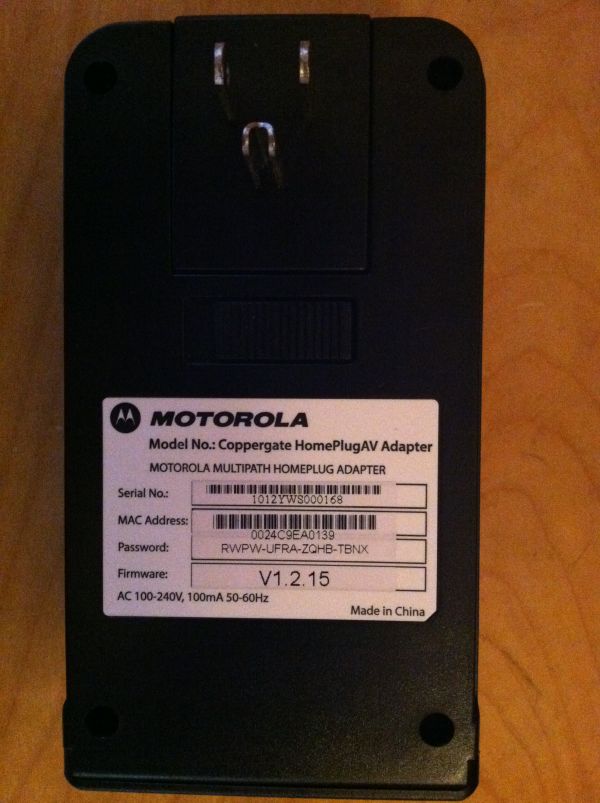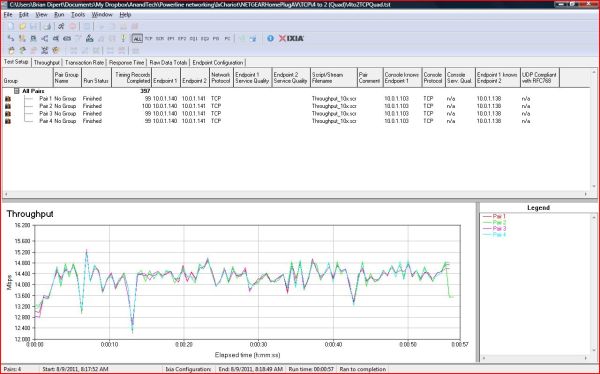Hands-On Powerline Networking: How Well (Or Not) Are Latest-Generation Devices Working?
by Brian Dipert on September 1, 2011 12:41 AM EST- Posted in
- Networking
- Powerline Adapters
- NetGear
Speaking of adapters, which ones received scrutiny in this study? The five 'base case' adapters were Netgear's XAV2001 HomePlug AV 200 units, which I made sure beforehand were upgraded to the latest-available v0.2.0.5NA firmware release, and are based on the Qualcomm third-generation INT6400 chipset:
Sigma Designs' CG2110 chipset was the foundation of the Motorola-branded (and Sigma Designs-supplied) second HomePlug AV adapter suite that I tested. These particular units offer three-prong power plugs, thereby at least conceptually implementing Sigma Designs' earlier-mentioned ClearPath technology for optionally routing powerline networking traffic over the earth ground connection:
Note that in this particular case, I was unfortunately only able to obtain three adapters from Sigma Designs, two of which I had connected to the powerline network nodes under test at any particular time, and the third mated to the router. The reason for mentioning this discrepancy will become clear in the next section of this article.
And at the performance high end, at least on paper, are Netgear's five XAV5001 IEEE 1901 adapters, derived from Qualcomm's latest-generation AR7400 chipset. As with the XAV2001s, I made sure that they were updated to the latest-available public firmware (v0.2.0.9NA in this particular case) before subjecting them to my barrage of tests:
Although at any particular point in time I was only measuring bandwidth between any two adapters, I had all of the adapters of any particular technology (five each for Netgear HomePlug AV and IEEE 1901, three for Sigma Designs/Motorola HomePlug AV) connected to the power grid at all times. As with my earlier description of static-vs-DHCP IP address assignments, this decision might not have enabled any particular adapter to operate at highest possible performance, because it was periodically (albeit briefly) interacting with all of its peers on the premises' power grid. However, such a setup more accurately mimics the way that powerline adapters will be operating in real-life usage settings, which is why I went this route (poor networking pun intended).
I harnessed the Ixia-supplied 'Throughput.scr' script, albeit customizing it to extend the test time by increasing the test-data payload size from 100 KBytes to 1 MByte. And, having learned through past testing situations that powerline adapters (and, more generally, all types of networking equipment) sometimes deliver higher aggregate throughput when more than one stream's worth of data is simultaneously flowing through them, I ran both one- and four-stream testing scenarios:














53 Comments
View All Comments
metageek - Thursday, September 1, 2011 - link
So, what happens if a power surge comes in through the outlet? Do these things include surge suppression, or is that surge going to travel out over the Ethernet cable and fry your computer?kmmatney - Thursday, September 1, 2011 - link
They have built-in power surge features. These are mainly used to keep the network signal clean, but they also protect the device.metageek - Thursday, September 1, 2011 - link
Thanks.ranster - Thursday, September 1, 2011 - link
I've been using Linksys PLE200s in my home for a long time now. I got the first pair (sold as a PLK200) for like $140, then later Sears had a sale online for $90, a good deal at the time, so I got another pair. I picked up a third pair off ebay for $14 since only one worked, but not an issue to add on just one. Lastly, I got a new PLK when Circuit City was going out of business, for a mighty good price. I have five of the seven in use, and the Linksys utility shows throughput from ~60Mbit to ~130 Mbit, depending on which PLE and its location in the house.I might check into the newest standard since they are said to interoperate with the HomePlug AV standard that PLE200s use.
durinbug - Thursday, September 1, 2011 - link
I've been interested in powerline networking for the last couple of years, and I appreciate the attempt to do a thorough investigation of the technology, but the results just don't turn out to be useful.I've been considering connecting my PS3 in the living room with the router (and desktop) in my office. Right now I use 802.11g (since the PS3 doesn't support n), which nets me a connection speed that ranges from ~10-15 mbps (a laptop also on G in the same location gets 30-40 mbps - the PS3 wireless adapter really seems to be craptastic). This is sufficient for playing games, but can be a major headache for streaming video.
While the throughput data you present here suggests that powerline networking might be an improvement, it doesn't really help make that decision. At an apparent average of about 30-40 mbps that you got, it wouldn't take a whole lot of interference to bring it down to the speeds I'm seeing already.
That said, I understand why you wanted to show the "best case" - I just wish you had also shown the "normal use" case so we might have some idea of the potential speed reduction we might see. I have numerous compact fluorescent lights, refrigerator, etc. (plus living room and office are on separate breakers, don't know about phases) - so even after reading your article I am no closer to knowing whether powerline networking will work for me. So after all the work of writing the article, the take-away seems to be "this is what I got; I have no idea what performance you will see."
bdipert - Thursday, September 1, 2011 - link
Dear durinbug, I appreciate the feedback. The fundamental issue that a reviewer such as myself always struggles with in a situation iike this (or Wi-Fi or phoneline or coax, for that matter...any non-networking-optimized interconnect media) is what is 'normal'. Note that my testing (for unfortunate reasons that I discuss in the article) was TCP-only, whereas your streaming situation would likely use UDP instead. From my past experience with powerline products, you would likely experience a 50%-to-100% performance improvement in average UDP transfer rate versus the TCP numbers that I published. Every technology subsequent to first-generation HomePlug 1.0 has focused the bulk of its development and implementation attention on UDP (for likely obvious reasons)demonbug - Thursday, September 1, 2011 - link
I appreciate the response, and wanted to reiterate that I really do appreciate the in-depth information and test results you provided. It would just be nice to get some sense of the impact on performance things like running the refrigerator or CFLs might have, even if your case doesn't represent the "normal". There is enough variability in throughput as it is, even with the semi-idealized setup (lights off, etc), that I'm a little concerned about maintaining throughput with such sources of interference present.Your mentioning that you generally see 50%-100% faster UDP transfer rates makes me hopeful that it actually would be a significant improvement over what I have now (and save me from trying to run cat5 through an exterior wall, which looks to be no fun at all), so I just might have to go and pick a couple up.
dennishodge - Thursday, September 1, 2011 - link
Now that the Sonos Bridge is only $50, went Sonos and bought an extra Bridge just to plug my laser printer into. I used to have powerline ethernet but the devices were flaky and eventually the last pair died. Each Sonos component has 1-2 10/100 switches. I haven't done a speed test, but the latency is superb. I even have an old wifi router plugged into a Sonos amp in one end of the house to extend my wifi coverage for weak devices like cell phones.It would be cool to trial two $50 bridges vs. powerline ethernet :-)
- Dennis
EarthwormJim - Thursday, September 1, 2011 - link
It seems to me for about the same cost as some of these high speed powerline networking setups, you could just hire an electrician to wire some ethernet jacks throughout your house.bdipert - Thursday, September 1, 2011 - link
Dear EarthwormJim, the hourly labor rate for electricians must be much lower where you live than where I do ;-) Your comment also prompts me to make a related point...retrofitting an existing structure for Cat5e by "burrowing through dirty, spider- and snake-infested crawlspaces" underneath floors (of which I have repeated past personal experience, back where I used to live in Sacramento CA) isn't even an option for a basement- and crawlspace-less residence built directly on a concrete slab...